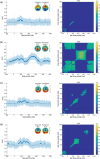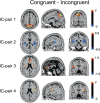Response stopping under conflict: The integrative role of representational dynamics associated with the insular cortex
- PMID: 38664992
- PMCID: PMC11046082
- DOI: 10.1002/hbm.26643
Response stopping under conflict: The integrative role of representational dynamics associated with the insular cortex
Abstract
Coping with distracting inputs during goal-directed behavior is a common challenge, especially when stopping ongoing responses. The neural basis for this remains debated. Our study explores this using a conflict-modulation Stop Signal task, integrating group independent component analysis (group-ICA), multivariate pattern analysis (MVPA), and EEG source localization analysis. Consistent with previous findings, we show that stopping performance is better in congruent (nonconflicting) trials than in incongruent (conflicting) trials. Conflict effects in incongruent trials compromise stopping more due to the need for the reconfiguration of stimulus-response (S-R) mappings. These cognitive dynamics are reflected by four independent neural activity patterns (ICA), each coding representational content (MVPA). It is shown that each component was equally important in predicting behavioral outcomes. The data support an emerging idea that perception-action integration in action-stopping involves multiple independent neural activity patterns. One pattern relates to the precuneus (BA 7) and is involved in attention and early S-R processes. Of note, three other independent neural activity patterns were associated with the insular cortex (BA13) in distinct time windows. These patterns reflect a role in early attentional selection but also show the reiterated processing of representational content relevant for stopping in different S-R mapping contexts. Moreover, the insular cortex's role in automatic versus complex response selection in relation to stopping processes is shown. Overall, the insular cortex is depicted as a brain hub, crucial for response selection and cancellation across both straightforward (automatic) and complex (conditional) S-R mappings, providing a neural basis for general cognitive accounts on action control.
Keywords: EEG; MVPA; action control; group ICA; insular cortex; stopping; superior parietal cortex.
© 2024 The Authors. Human Brain Mapping published by Wiley Periodicals LLC.
Conflict of interest statement
The authors declare no conflicts of interest.
Figures





Similar articles
-
Neural Architecture of Selective Stopping Strategies: Distinct Brain Activity Patterns Are Associated with Attentional Capture But Not with Outright Stopping.J Neurosci. 2017 Oct 4;37(40):9785-9794. doi: 10.1523/JNEUROSCI.1476-17.2017. Epub 2017 Sep 8. J Neurosci. 2017. PMID: 28887387 Free PMC article.
-
Common and Unique Inhibitory Control Signatures of Action-Stopping and Attentional Capture Suggest That Actions Are Stopped in Two Stages.J Neurosci. 2021 Oct 20;41(42):8826-8838. doi: 10.1523/JNEUROSCI.1105-21.2021. Epub 2021 Sep 7. J Neurosci. 2021. PMID: 34493541 Free PMC article.
-
The metacontrol of event segmentation-A neurophysiological and behavioral perspective.Hum Brain Mapp. 2024 Aug 1;45(11):e26727. doi: 10.1002/hbm.26727. Hum Brain Mapp. 2024. PMID: 39081074 Free PMC article.
-
Stopping Interference in Response Inhibition: Behavioral and Neural Signatures of Selective Stopping.J Neurosci. 2022 Jan 12;42(2):156-165. doi: 10.1523/JNEUROSCI.0668-21.2021. J Neurosci. 2022. PMID: 35022327 Free PMC article. Review.
-
Partial response electromyography as a marker of action stopping.Elife. 2022 May 26;11:e70332. doi: 10.7554/eLife.70332. Elife. 2022. PMID: 35617120 Free PMC article. Review.
Cited by
-
Metacontrol instructions lead to adult-like event segmentation in adolescents.Dev Cogn Neurosci. 2025 Apr;72:101521. doi: 10.1016/j.dcn.2025.101521. Epub 2025 Jan 30. Dev Cogn Neurosci. 2025. PMID: 39892154 Free PMC article.
References
-
- Aron, A. R. (2011). From reactive to proactive and selective control: Developing a richer model for stopping inappropriate responses. Biological Psychiatry, 69, e55–e68. Retrieved from https://www.sciencedirect.com/science/article/pii/S0006322310008103 - PMC - PubMed
-
- Bari, A. , & Robbins, T. W. (2013). Inhibition and impulsivity: Behavioral and neural basis of response control. Progress in Neurobiology, 108, 44–79. Retrieved from https://linkinghub.elsevier.com/retrieve/pii/S0301008213000543 - PubMed
Publication types
MeSH terms
Grants and funding
LinkOut - more resources
Full Text Sources
Research Materials
Miscellaneous

